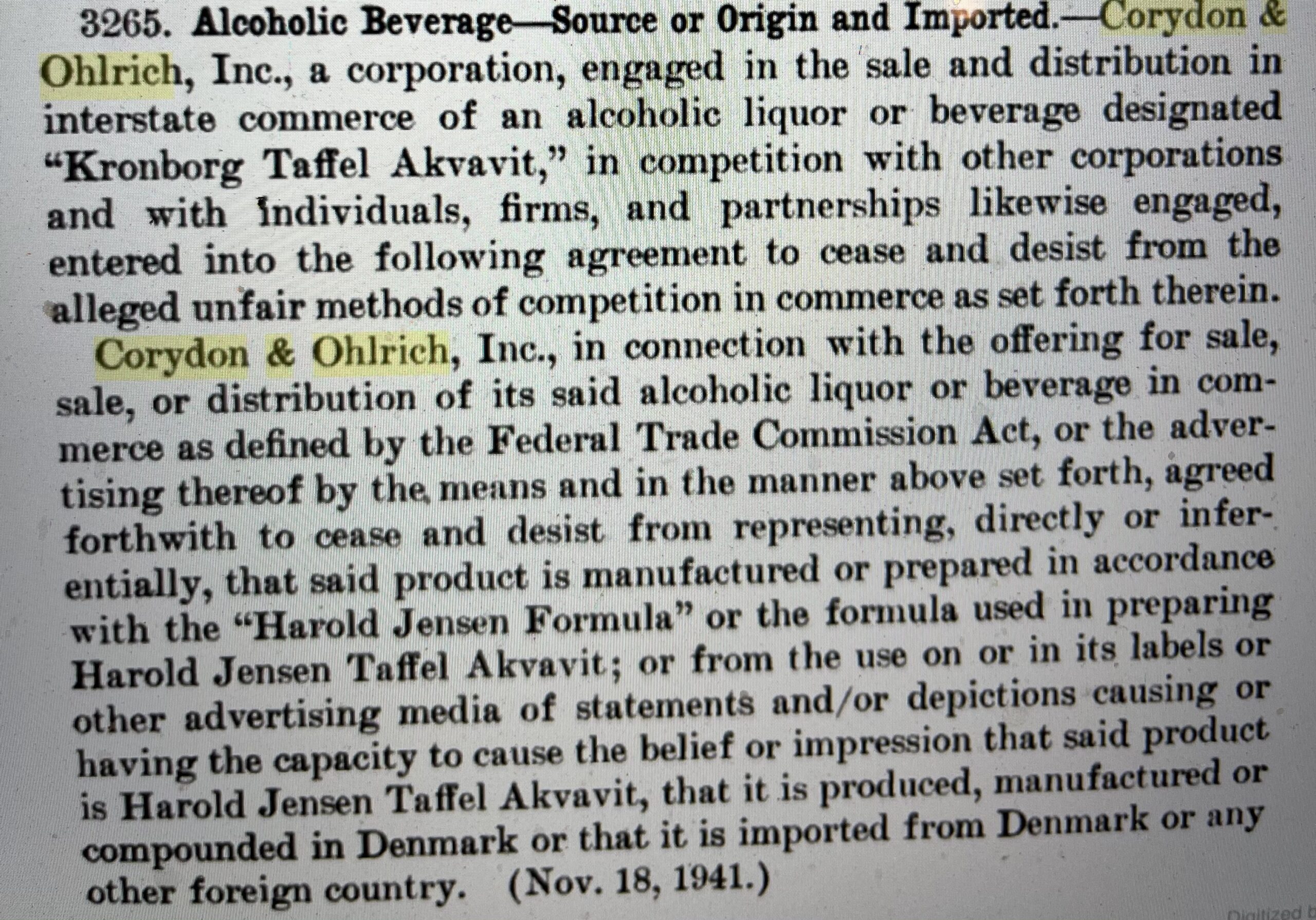 47cm x 35cm
The old Smithwicks brewery is on the site of a Franciscan abbey, where monks had brewed ale since the 14th century, and ruins of the original abbey still remain on its grounds. The old brewery has since been renovated and now hosts "The Smithwick's Experience Kilkenny" visitor attraction and centre.At the time of its closure, it was Ireland's oldest operating brewery.
John Smithwick was an orphan who had settled in Kilkenny. Shortly after his arrival, Smithwick went into the brewing business with Richard Cole on a piece of land that Cole had leased from the Duke of Ormond in 1705. Five years later, John Smithwick became the owner of the land. The brewery stayed small, servicing a loyal local following while John Smithwick diversified.
Following John Smithwick's death, the brewery temporarily fell out of family hands. John Smithwick's great grandson, Edmond bought the brewery land back freehold and worked to reshape its future. Edmond concentrated on discovering new markets and successfully building export trade. Drinkers in England, Scotland and Wales developed a taste for Smithwick's brews and output increased fivefold.
As a result of substantial contributions made to St Mary's Cathedral, Edmond became great friends with Irish liberal Daniel O'Connell, who later became godfather to one of his sons. Edmond Smithwick became well known and respected by the people of Kilkenny who elected him town mayor four times.
In 1800, export sales began to fall and the brewing industry encountered difficulty. To combat this, the Smithwick family increased production in their maltings, began selling mineral water and delivered butter with the ale from the back of their drays.By 1900, output was at an all-time low and the then owner James Smithwick was advised by auditors to shut the doors of the brewery. Instead, James reduced the range of beers they produced and set out to find new markets. He secured military contracts and soon after saw output increase again. James' son, Walter, took control in 1930 and steered the brewery to success through the hardships of both World War II and increasingly challenging weather conditions.By January 1950, Smithwick's was exporting ale to Boston.Smithwick's was purchased from Walter Smithwick in 1965 by Guinness and is now, along with Guinness, part of Diageo. Together, Guinness & Co. and Smithwick's developed and launched Smithwick's Draught Ale in 1966. By 1979, half a million barrels were sold each year.In 1980, Smithwick's began exporting to France. In 1993, Smithwick's Draught became Canada's leading imported ale.By 2010, Smithwick's continued to be brewed in Dundalk and Kilkenny with tankers sent to Dublin to be kegged for the on trade market. Cans and bottles were packaged by IBC in Belfast.Production in the Kilkenny brewery finished on 31 December 2013 and Smithwicks brands are now produced in the Diageo St.James' Gate brewery in Dublin.The original Kilkenny site was sold to Kilkenny County Council, with a small portion of the site dedicated to the opening of a visitor's centre, the "Smithwick's Experience Kilkenny".
47cm x 35cm
The old Smithwicks brewery is on the site of a Franciscan abbey, where monks had brewed ale since the 14th century, and ruins of the original abbey still remain on its grounds. The old brewery has since been renovated and now hosts "The Smithwick's Experience Kilkenny" visitor attraction and centre.At the time of its closure, it was Ireland's oldest operating brewery.
John Smithwick was an orphan who had settled in Kilkenny. Shortly after his arrival, Smithwick went into the brewing business with Richard Cole on a piece of land that Cole had leased from the Duke of Ormond in 1705. Five years later, John Smithwick became the owner of the land. The brewery stayed small, servicing a loyal local following while John Smithwick diversified.
Following John Smithwick's death, the brewery temporarily fell out of family hands. John Smithwick's great grandson, Edmond bought the brewery land back freehold and worked to reshape its future. Edmond concentrated on discovering new markets and successfully building export trade. Drinkers in England, Scotland and Wales developed a taste for Smithwick's brews and output increased fivefold.
As a result of substantial contributions made to St Mary's Cathedral, Edmond became great friends with Irish liberal Daniel O'Connell, who later became godfather to one of his sons. Edmond Smithwick became well known and respected by the people of Kilkenny who elected him town mayor four times.
In 1800, export sales began to fall and the brewing industry encountered difficulty. To combat this, the Smithwick family increased production in their maltings, began selling mineral water and delivered butter with the ale from the back of their drays.By 1900, output was at an all-time low and the then owner James Smithwick was advised by auditors to shut the doors of the brewery. Instead, James reduced the range of beers they produced and set out to find new markets. He secured military contracts and soon after saw output increase again. James' son, Walter, took control in 1930 and steered the brewery to success through the hardships of both World War II and increasingly challenging weather conditions.By January 1950, Smithwick's was exporting ale to Boston.Smithwick's was purchased from Walter Smithwick in 1965 by Guinness and is now, along with Guinness, part of Diageo. Together, Guinness & Co. and Smithwick's developed and launched Smithwick's Draught Ale in 1966. By 1979, half a million barrels were sold each year.In 1980, Smithwick's began exporting to France. In 1993, Smithwick's Draught became Canada's leading imported ale.By 2010, Smithwick's continued to be brewed in Dundalk and Kilkenny with tankers sent to Dublin to be kegged for the on trade market. Cans and bottles were packaged by IBC in Belfast.Production in the Kilkenny brewery finished on 31 December 2013 and Smithwicks brands are now produced in the Diageo St.James' Gate brewery in Dublin.The original Kilkenny site was sold to Kilkenny County Council, with a small portion of the site dedicated to the opening of a visitor's centre, the "Smithwick's Experience Kilkenny".
-
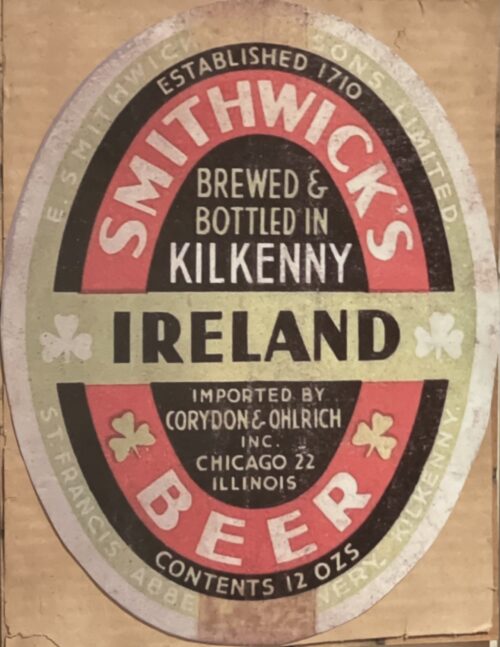

 47cm x 35cm
The old Smithwicks brewery is on the site of a Franciscan abbey, where monks had brewed ale since the 14th century, and ruins of the original abbey still remain on its grounds. The old brewery has since been renovated and now hosts "The Smithwick's Experience Kilkenny" visitor attraction and centre.At the time of its closure, it was Ireland's oldest operating brewery.
John Smithwick was an orphan who had settled in Kilkenny. Shortly after his arrival, Smithwick went into the brewing business with Richard Cole on a piece of land that Cole had leased from the Duke of Ormond in 1705. Five years later, John Smithwick became the owner of the land. The brewery stayed small, servicing a loyal local following while John Smithwick diversified.
Following John Smithwick's death, the brewery temporarily fell out of family hands. John Smithwick's great grandson, Edmond bought the brewery land back freehold and worked to reshape its future. Edmond concentrated on discovering new markets and successfully building export trade. Drinkers in England, Scotland and Wales developed a taste for Smithwick's brews and output increased fivefold.
As a result of substantial contributions made to St Mary's Cathedral, Edmond became great friends with Irish liberal Daniel O'Connell, who later became godfather to one of his sons. Edmond Smithwick became well known and respected by the people of Kilkenny who elected him town mayor four times.
In 1800, export sales began to fall and the brewing industry encountered difficulty. To combat this, the Smithwick family increased production in their maltings, began selling mineral water and delivered butter with the ale from the back of their drays.By 1900, output was at an all-time low and the then owner James Smithwick was advised by auditors to shut the doors of the brewery. Instead, James reduced the range of beers they produced and set out to find new markets. He secured military contracts and soon after saw output increase again. James' son, Walter, took control in 1930 and steered the brewery to success through the hardships of both World War II and increasingly challenging weather conditions.By January 1950, Smithwick's was exporting ale to Boston.Smithwick's was purchased from Walter Smithwick in 1965 by Guinness and is now, along with Guinness, part of Diageo. Together, Guinness & Co. and Smithwick's developed and launched Smithwick's Draught Ale in 1966. By 1979, half a million barrels were sold each year.In 1980, Smithwick's began exporting to France. In 1993, Smithwick's Draught became Canada's leading imported ale.By 2010, Smithwick's continued to be brewed in Dundalk and Kilkenny with tankers sent to Dublin to be kegged for the on trade market. Cans and bottles were packaged by IBC in Belfast.Production in the Kilkenny brewery finished on 31 December 2013 and Smithwicks brands are now produced in the Diageo St.James' Gate brewery in Dublin.The original Kilkenny site was sold to Kilkenny County Council, with a small portion of the site dedicated to the opening of a visitor's centre, the "Smithwick's Experience Kilkenny".
47cm x 35cm
The old Smithwicks brewery is on the site of a Franciscan abbey, where monks had brewed ale since the 14th century, and ruins of the original abbey still remain on its grounds. The old brewery has since been renovated and now hosts "The Smithwick's Experience Kilkenny" visitor attraction and centre.At the time of its closure, it was Ireland's oldest operating brewery.
John Smithwick was an orphan who had settled in Kilkenny. Shortly after his arrival, Smithwick went into the brewing business with Richard Cole on a piece of land that Cole had leased from the Duke of Ormond in 1705. Five years later, John Smithwick became the owner of the land. The brewery stayed small, servicing a loyal local following while John Smithwick diversified.
Following John Smithwick's death, the brewery temporarily fell out of family hands. John Smithwick's great grandson, Edmond bought the brewery land back freehold and worked to reshape its future. Edmond concentrated on discovering new markets and successfully building export trade. Drinkers in England, Scotland and Wales developed a taste for Smithwick's brews and output increased fivefold.
As a result of substantial contributions made to St Mary's Cathedral, Edmond became great friends with Irish liberal Daniel O'Connell, who later became godfather to one of his sons. Edmond Smithwick became well known and respected by the people of Kilkenny who elected him town mayor four times.
In 1800, export sales began to fall and the brewing industry encountered difficulty. To combat this, the Smithwick family increased production in their maltings, began selling mineral water and delivered butter with the ale from the back of their drays.By 1900, output was at an all-time low and the then owner James Smithwick was advised by auditors to shut the doors of the brewery. Instead, James reduced the range of beers they produced and set out to find new markets. He secured military contracts and soon after saw output increase again. James' son, Walter, took control in 1930 and steered the brewery to success through the hardships of both World War II and increasingly challenging weather conditions.By January 1950, Smithwick's was exporting ale to Boston.Smithwick's was purchased from Walter Smithwick in 1965 by Guinness and is now, along with Guinness, part of Diageo. Together, Guinness & Co. and Smithwick's developed and launched Smithwick's Draught Ale in 1966. By 1979, half a million barrels were sold each year.In 1980, Smithwick's began exporting to France. In 1993, Smithwick's Draught became Canada's leading imported ale.By 2010, Smithwick's continued to be brewed in Dundalk and Kilkenny with tankers sent to Dublin to be kegged for the on trade market. Cans and bottles were packaged by IBC in Belfast.Production in the Kilkenny brewery finished on 31 December 2013 and Smithwicks brands are now produced in the Diageo St.James' Gate brewery in Dublin.The original Kilkenny site was sold to Kilkenny County Council, with a small portion of the site dedicated to the opening of a visitor's centre, the "Smithwick's Experience Kilkenny".
-
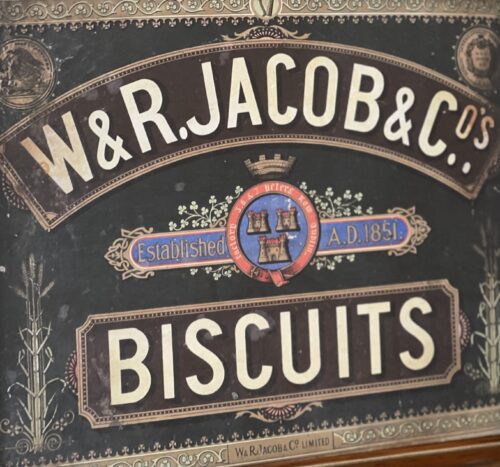
 40cm x 34cm LimerickThe biscuit making firm of W. & R. Jacob's were one the largest employers in the Dublin of 1916, and their factory was seized on Easter Monday by perhaps 100 members of the 2nd Battalion of the Dublin Brigade of the Irish Volunteers under Thomas MacDonagh. The factory itself was an enormous and formidable Victorian edifice located on the 'block' enclosed by Bishop St, Bride St, Peter's St and Peter's Row, and between St Patrick's Cathedral and St Stephen's Green. Its seizure helped to complete a loop of building cross the south inner city; the factory had two large towers that could act as observation points, while its location was very close to both Camden St and Patrick St: natural routeways for troops entering the city centre from Portobello Barracks in Rathmines and Wellington Barracks on the South Circular Road. There were only a few staff present in the building when the Volunteers broke into it; a number of smaller outposts were established in the area around the factory. While the garrison saw some fighting early in the week, their principal enemies proved to be boredom and the locals: the factory was surrounded by tenements, and the Volunteers were attacked and abused by residents, many of whom were Jacob's workers themselves. The families of servicemen were also quite hostile, but there may have been another reason for this hostility: Michael O'Hanrahan, who was in Jacob's, expressed his concern that the choice of location might endanger local residents if the British chose to attack. As it happens, the factory was largely by-passed, though it was fired upon intermittently throughout the week by troops in Dublin Castle and elsewhere. MacDonagh surrendered in nearby St Patrick's Park on Sunday 30 April; some of the factory was looted after the Volunteers had left. Three members of the Jacob's garrison were executed. Most of the factory was eventually demolished, though fragments of the ground storey and one of the towers are still visible on Bishop St between the DIT campus on Aungier St and the National Archives of Ireland.
40cm x 34cm LimerickThe biscuit making firm of W. & R. Jacob's were one the largest employers in the Dublin of 1916, and their factory was seized on Easter Monday by perhaps 100 members of the 2nd Battalion of the Dublin Brigade of the Irish Volunteers under Thomas MacDonagh. The factory itself was an enormous and formidable Victorian edifice located on the 'block' enclosed by Bishop St, Bride St, Peter's St and Peter's Row, and between St Patrick's Cathedral and St Stephen's Green. Its seizure helped to complete a loop of building cross the south inner city; the factory had two large towers that could act as observation points, while its location was very close to both Camden St and Patrick St: natural routeways for troops entering the city centre from Portobello Barracks in Rathmines and Wellington Barracks on the South Circular Road. There were only a few staff present in the building when the Volunteers broke into it; a number of smaller outposts were established in the area around the factory. While the garrison saw some fighting early in the week, their principal enemies proved to be boredom and the locals: the factory was surrounded by tenements, and the Volunteers were attacked and abused by residents, many of whom were Jacob's workers themselves. The families of servicemen were also quite hostile, but there may have been another reason for this hostility: Michael O'Hanrahan, who was in Jacob's, expressed his concern that the choice of location might endanger local residents if the British chose to attack. As it happens, the factory was largely by-passed, though it was fired upon intermittently throughout the week by troops in Dublin Castle and elsewhere. MacDonagh surrendered in nearby St Patrick's Park on Sunday 30 April; some of the factory was looted after the Volunteers had left. Three members of the Jacob's garrison were executed. Most of the factory was eventually demolished, though fragments of the ground storey and one of the towers are still visible on Bishop St between the DIT campus on Aungier St and the National Archives of Ireland. -
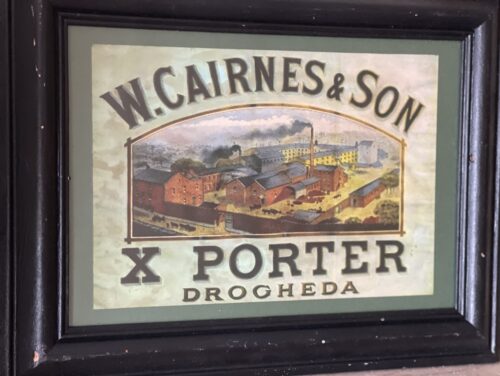
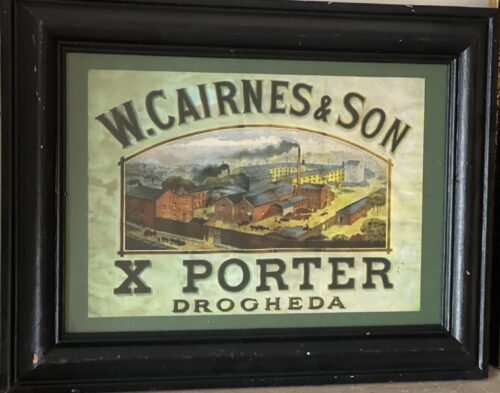 38cm x 30cm Drogheda W.Cairnes & Son Ltd, Drogheda, Co Louth, Ireland. Founded 1828 by William Cairnes. Registered April 1890 as the Castlebellingham & Drogheda Breweries Ltd. to acquire John Woolsey & Co. Ltd, Castlebellingham and William Cairnes & Son. Name changed as above in November 1933. Acquired by Guinness and ceased brewing in October 1959. From the Brewery History Society Journal Number 91 Founded in 1828 by William Cairnes with good markets in both Dublin and Belfast. In 1850 they extended their malt liquor portfolio to include porter. The brewery was closed in 1959 as part of a rationalisation plan when the Cherry-Cairnes partnership was dissolved, to be subsequently replaced by the Irish Ale Breweries Group, (a Guinness/Allied Breweries combination). Irish Ale Breweries was formally dissolved in 1988, becoming Guinness Ireland.
38cm x 30cm Drogheda W.Cairnes & Son Ltd, Drogheda, Co Louth, Ireland. Founded 1828 by William Cairnes. Registered April 1890 as the Castlebellingham & Drogheda Breweries Ltd. to acquire John Woolsey & Co. Ltd, Castlebellingham and William Cairnes & Son. Name changed as above in November 1933. Acquired by Guinness and ceased brewing in October 1959. From the Brewery History Society Journal Number 91 Founded in 1828 by William Cairnes with good markets in both Dublin and Belfast. In 1850 they extended their malt liquor portfolio to include porter. The brewery was closed in 1959 as part of a rationalisation plan when the Cherry-Cairnes partnership was dissolved, to be subsequently replaced by the Irish Ale Breweries Group, (a Guinness/Allied Breweries combination). Irish Ale Breweries was formally dissolved in 1988, becoming Guinness Ireland. -
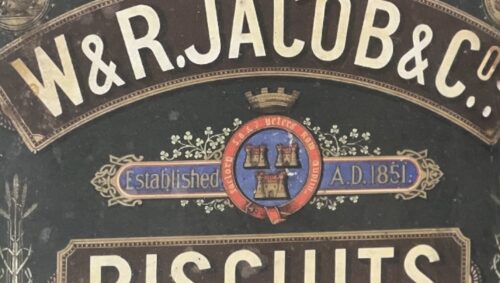
 42cm x 32cm Limerick The Jacobs Biscuit Bakery originated in Waterford in 1851,after being founded by William Beale Jacob and his brother Robert.It later moved to Bishop Street in Dublin with a further factory in Peters Row.Jacobs Bishop Street premises was occupied as a strategic location by rebels during the 1916 Easter Rebellion. W. & R. Jacob's were one the largest employers in the Dublin of 1916, and their factory was seized on Easter Monday by perhaps 100 members of the 2nd Battalion of the Dublin Brigade of the Irish Volunteers under Thomas MacDonagh. The factory itself was an enormous and formidable Victorian edifice located on the 'block' enclosed by Bishop St, Bride St, Peter's St and Peter's Row, and between St Patrick's Cathedral and St Stephen's Green. Its seizure helped to complete a loop of building cross the south inner city; the factory had two large towers that could act as observation points, while its location was very close to both Camden St and Patrick St: natural routeways for troops entering the city centre from Portobello Barracks in Rathmines and Wellington Barracks on the South Circular Road. There were only a few staff present in the building when the Volunteers broke into it; a number of smaller outposts were established in the area around the factory. While the garrison saw some fighting early in the week, their principal enemies proved to be boredom and the locals: the factory was surrounded by tenements, and the Volunteers were attacked and abused by residents, many of whom were Jacob's workers themselves. The families of servicemen were also quite hostile, but there may have been another reason for this hostility: Michael O'Hanrahan, who was in Jacob's, expressed his concern that the choice of location might endanger local residents if the British chose to attack. As it happens, the factory was largely by-passed, though it was fired upon intermittently throughout the week by troops in Dublin Castle and elsewhere. MacDonagh surrendered in nearby St Patrick's Park on Sunday 30 April; some of the factory was looted after the Volunteers had left. Three members of the Jacob's garrison were executed. Most of the factory was eventually demolished, though fragments of the ground storey and one of the towers are still visible on Bishop St between the DIT campus on Aungier St and the National Archives of Ireland.
42cm x 32cm Limerick The Jacobs Biscuit Bakery originated in Waterford in 1851,after being founded by William Beale Jacob and his brother Robert.It later moved to Bishop Street in Dublin with a further factory in Peters Row.Jacobs Bishop Street premises was occupied as a strategic location by rebels during the 1916 Easter Rebellion. W. & R. Jacob's were one the largest employers in the Dublin of 1916, and their factory was seized on Easter Monday by perhaps 100 members of the 2nd Battalion of the Dublin Brigade of the Irish Volunteers under Thomas MacDonagh. The factory itself was an enormous and formidable Victorian edifice located on the 'block' enclosed by Bishop St, Bride St, Peter's St and Peter's Row, and between St Patrick's Cathedral and St Stephen's Green. Its seizure helped to complete a loop of building cross the south inner city; the factory had two large towers that could act as observation points, while its location was very close to both Camden St and Patrick St: natural routeways for troops entering the city centre from Portobello Barracks in Rathmines and Wellington Barracks on the South Circular Road. There were only a few staff present in the building when the Volunteers broke into it; a number of smaller outposts were established in the area around the factory. While the garrison saw some fighting early in the week, their principal enemies proved to be boredom and the locals: the factory was surrounded by tenements, and the Volunteers were attacked and abused by residents, many of whom were Jacob's workers themselves. The families of servicemen were also quite hostile, but there may have been another reason for this hostility: Michael O'Hanrahan, who was in Jacob's, expressed his concern that the choice of location might endanger local residents if the British chose to attack. As it happens, the factory was largely by-passed, though it was fired upon intermittently throughout the week by troops in Dublin Castle and elsewhere. MacDonagh surrendered in nearby St Patrick's Park on Sunday 30 April; some of the factory was looted after the Volunteers had left. Three members of the Jacob's garrison were executed. Most of the factory was eventually demolished, though fragments of the ground storey and one of the towers are still visible on Bishop St between the DIT campus on Aungier St and the National Archives of Ireland. -
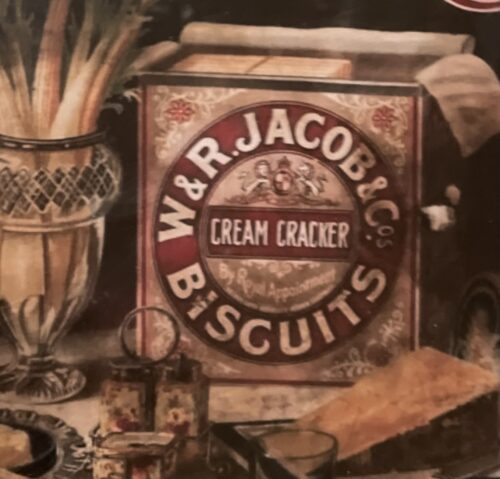
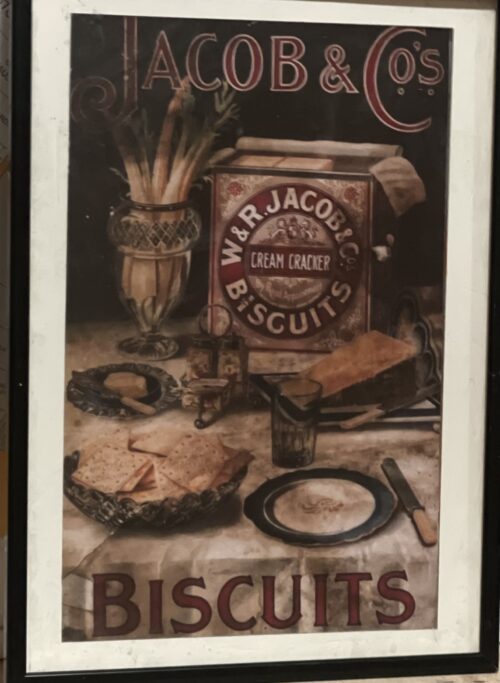 46cm x 39cm Limerick The Jacobs Biscuit Bakery originated in Waterford in 1851,after being founded by William Beale Jacob and his brother Robert.It later moved to Bishop Street in Dublin with a further factory in Peters Row.Jacobs Bishop Street premises was occupied as a strategic location by rebels during the 1916 Easter Rebellion. W. & R. Jacob's were one the largest employers in the Dublin of 1916, and their factory was seized on Easter Monday by perhaps 100 members of the 2nd Battalion of the Dublin Brigade of the Irish Volunteers under Thomas MacDonagh. The factory itself was an enormous and formidable Victorian edifice located on the 'block' enclosed by Bishop St, Bride St, Peter's St and Peter's Row, and between St Patrick's Cathedral and St Stephen's Green. Its seizure helped to complete a loop of building cross the south inner city; the factory had two large towers that could act as observation points, while its location was very close to both Camden St and Patrick St: natural routeways for troops entering the city centre from Portobello Barracks in Rathmines and Wellington Barracks on the South Circular Road. There were only a few staff present in the building when the Volunteers broke into it; a number of smaller outposts were established in the area around the factory. While the garrison saw some fighting early in the week, their principal enemies proved to be boredom and the locals: the factory was surrounded by tenements, and the Volunteers were attacked and abused by residents, many of whom were Jacob's workers themselves. The families of servicemen were also quite hostile, but there may have been another reason for this hostility: Michael O'Hanrahan, who was in Jacob's, expressed his concern that the choice of location might endanger local residents if the British chose to attack. As it happens, the factory was largely by-passed, though it was fired upon intermittently throughout the week by troops in Dublin Castle and elsewhere. MacDonagh surrendered in nearby St Patrick's Park on Sunday 30 April; some of the factory was looted after the Volunteers had left. Three members of the Jacob's garrison were executed. Most of the factory was eventually demolished, though fragments of the ground storey and one of the towers are still visible on Bishop St between the DIT campus on Aungier St and the National Archives of Ireland.
46cm x 39cm Limerick The Jacobs Biscuit Bakery originated in Waterford in 1851,after being founded by William Beale Jacob and his brother Robert.It later moved to Bishop Street in Dublin with a further factory in Peters Row.Jacobs Bishop Street premises was occupied as a strategic location by rebels during the 1916 Easter Rebellion. W. & R. Jacob's were one the largest employers in the Dublin of 1916, and their factory was seized on Easter Monday by perhaps 100 members of the 2nd Battalion of the Dublin Brigade of the Irish Volunteers under Thomas MacDonagh. The factory itself was an enormous and formidable Victorian edifice located on the 'block' enclosed by Bishop St, Bride St, Peter's St and Peter's Row, and between St Patrick's Cathedral and St Stephen's Green. Its seizure helped to complete a loop of building cross the south inner city; the factory had two large towers that could act as observation points, while its location was very close to both Camden St and Patrick St: natural routeways for troops entering the city centre from Portobello Barracks in Rathmines and Wellington Barracks on the South Circular Road. There were only a few staff present in the building when the Volunteers broke into it; a number of smaller outposts were established in the area around the factory. While the garrison saw some fighting early in the week, their principal enemies proved to be boredom and the locals: the factory was surrounded by tenements, and the Volunteers were attacked and abused by residents, many of whom were Jacob's workers themselves. The families of servicemen were also quite hostile, but there may have been another reason for this hostility: Michael O'Hanrahan, who was in Jacob's, expressed his concern that the choice of location might endanger local residents if the British chose to attack. As it happens, the factory was largely by-passed, though it was fired upon intermittently throughout the week by troops in Dublin Castle and elsewhere. MacDonagh surrendered in nearby St Patrick's Park on Sunday 30 April; some of the factory was looted after the Volunteers had left. Three members of the Jacob's garrison were executed. Most of the factory was eventually demolished, though fragments of the ground storey and one of the towers are still visible on Bishop St between the DIT campus on Aungier St and the National Archives of Ireland. -
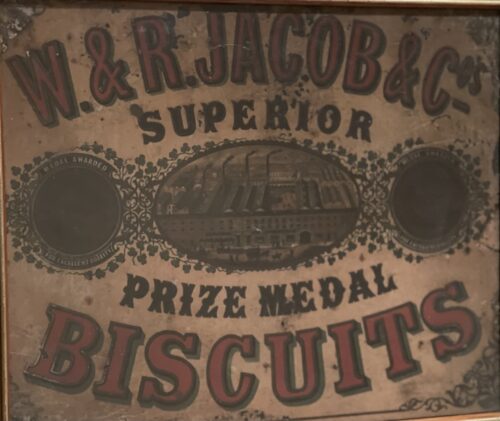
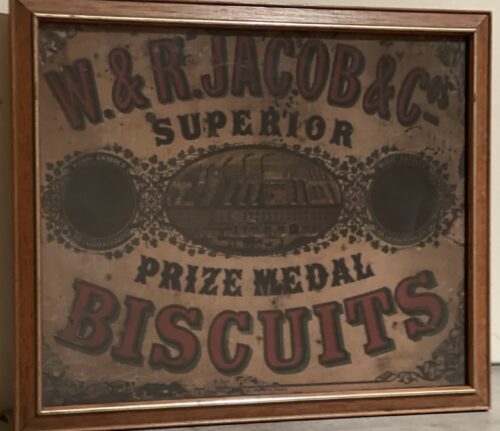 42cm x 32cm Limerick The Jacobs Biscuit Bakery originated in Waterford in 1851,after being founded by William Beale Jacob and his brother Robert.It later moved to Bishop Street in Dublin with a further factory in Peters Row.Jacobs Bishop Street premises was occupied as a strategic location by rebels during the 1916 Easter Rebellion. W. & R. Jacob's were one the largest employers in the Dublin of 1916, and their factory was seized on Easter Monday by perhaps 100 members of the 2nd Battalion of the Dublin Brigade of the Irish Volunteers under Thomas MacDonagh. The factory itself was an enormous and formidable Victorian edifice located on the 'block' enclosed by Bishop St, Bride St, Peter's St and Peter's Row, and between St Patrick's Cathedral and St Stephen's Green. Its seizure helped to complete a loop of building cross the south inner city; the factory had two large towers that could act as observation points, while its location was very close to both Camden St and Patrick St: natural routeways for troops entering the city centre from Portobello Barracks in Rathmines and Wellington Barracks on the South Circular Road. There were only a few staff present in the building when the Volunteers broke into it; a number of smaller outposts were established in the area around the factory. While the garrison saw some fighting early in the week, their principal enemies proved to be boredom and the locals: the factory was surrounded by tenements, and the Volunteers were attacked and abused by residents, many of whom were Jacob's workers themselves. The families of servicemen were also quite hostile, but there may have been another reason for this hostility: Michael O'Hanrahan, who was in Jacob's, expressed his concern that the choice of location might endanger local residents if the British chose to attack. As it happens, the factory was largely by-passed, though it was fired upon intermittently throughout the week by troops in Dublin Castle and elsewhere. MacDonagh surrendered in nearby St Patrick's Park on Sunday 30 April; some of the factory was looted after the Volunteers had left. Three members of the Jacob's garrison were executed. Most of the factory was eventually demolished, though fragments of the ground storey and one of the towers are still visible on Bishop St between the DIT campus on Aungier St and the National Archives of Ireland.
42cm x 32cm Limerick The Jacobs Biscuit Bakery originated in Waterford in 1851,after being founded by William Beale Jacob and his brother Robert.It later moved to Bishop Street in Dublin with a further factory in Peters Row.Jacobs Bishop Street premises was occupied as a strategic location by rebels during the 1916 Easter Rebellion. W. & R. Jacob's were one the largest employers in the Dublin of 1916, and their factory was seized on Easter Monday by perhaps 100 members of the 2nd Battalion of the Dublin Brigade of the Irish Volunteers under Thomas MacDonagh. The factory itself was an enormous and formidable Victorian edifice located on the 'block' enclosed by Bishop St, Bride St, Peter's St and Peter's Row, and between St Patrick's Cathedral and St Stephen's Green. Its seizure helped to complete a loop of building cross the south inner city; the factory had two large towers that could act as observation points, while its location was very close to both Camden St and Patrick St: natural routeways for troops entering the city centre from Portobello Barracks in Rathmines and Wellington Barracks on the South Circular Road. There were only a few staff present in the building when the Volunteers broke into it; a number of smaller outposts were established in the area around the factory. While the garrison saw some fighting early in the week, their principal enemies proved to be boredom and the locals: the factory was surrounded by tenements, and the Volunteers were attacked and abused by residents, many of whom were Jacob's workers themselves. The families of servicemen were also quite hostile, but there may have been another reason for this hostility: Michael O'Hanrahan, who was in Jacob's, expressed his concern that the choice of location might endanger local residents if the British chose to attack. As it happens, the factory was largely by-passed, though it was fired upon intermittently throughout the week by troops in Dublin Castle and elsewhere. MacDonagh surrendered in nearby St Patrick's Park on Sunday 30 April; some of the factory was looted after the Volunteers had left. Three members of the Jacob's garrison were executed. Most of the factory was eventually demolished, though fragments of the ground storey and one of the towers are still visible on Bishop St between the DIT campus on Aungier St and the National Archives of Ireland. -
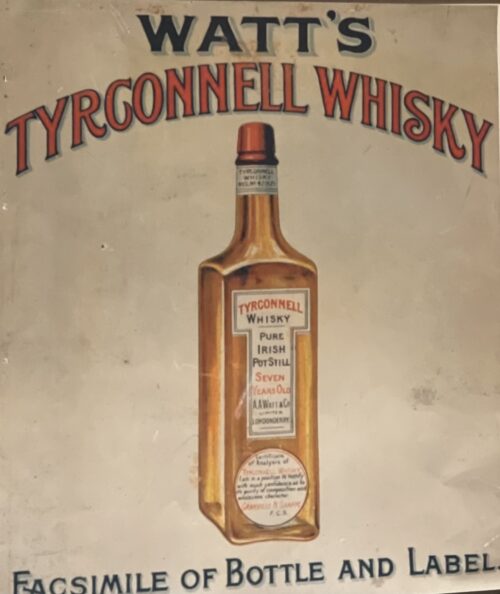
 67cm x 56cm This historic brand of whiskey has now been revived by the Cooley Distillery (which is now part of Beam Suntory).The brand was previously owned by the Watt Distillery, which (according to the company) dates back to 1762. The Tyrconnell was their flagship brand, and was named after a racehorse owned by Andrew Alexander Watt. The horse was a chestnut colt that won at 100 to 1 odds in 1876 in the Irish horse race called The National Produce Stakes.The actual horse race is depicted on the label. Tír Chonaill in the Irish Language comes from Tír meaning “Land of” and Chonaill which was the name of an ancient 5th Century High King of the North West of Ireland in the 5th century who was a son of the famous Niall of the Nine Hostages. Tyrconnell was therefore the name of this ancient North West Irish Kingdom and is still to this day used as the Irish language name of Donegal in the North West of Ireland. Tír Chonaill would have encompassed the modern county of Donegal and much of her neighbouring counties of Sligo, Leitrim, Fermanagh and Tyrone. The Kingdom survived until 1601. In 1876, the Donegal – Derry based Watt family who owned one of the largest whiskey distilleries in Ireland entered a racehorse called “Tyrconnell” (after the local ancient kingdom) in the Irish Classic “National Produce Stakes” where it won against all the odds at an incredible 100 to 1. This spectacular achievement inspired the Watt whiskey distillery in Derry to celebrate the occasion with a special commemorative Tyrconnell Irish whiskey label. The Tyrconnell was, before American prohibition, one of the biggest selling whiskey brands in the United States. Pre-prohibition photos taken in Yankee Stadium in New York show Tyrconnell Irish Whiskey billboards in positions of prominence at the venue. All three of the company’s whiskey brands enjoyed great success in the export sector. Sales in England, Canada, Australia, Nigeria and the West Indies and the U.S. put Derry on the commercial map as never before. Unfortunately, with the decline of Irish Whiskey after prohibition, Watts distillery and Tyrconnell whiskey faded and died like the majority of Irish whiskey distilleries and brands of the time. When the Cooley Irish Whiskey Distillery was recommissioned by Dr. John Teeling a few years ago, Tyrconnell was one of the old iconic Irish whiskey brands that Cooley brought back to life. Cooley Distillery and the Cooley Irish Whiskey brands are now owned by the Japanese – American whiskey giant Beam Suntory. Today, Tyrconnell whiskey is available as a standard 10 Year Old Cooley Single Malt and is also available through the Tyrconnell Irish Whiskey Finishes Collection in Port Pipe, Madeira Cask and Sherry Butt finishes at 46% abv as well as a 15 Year Old Single Cask expression. Andrew Watt (4 November 1853 – 11 October 1928) was an Anglo-Irish businessman with a net worth of over £900,000 at his death in 1928, worth £51.8 million in 2016.He was born in 1853 to Samuel Watt of Thornhill and his wife Jane Newman, daughter of Captain Robert Newman, R.N.. He was educated at Foyle College and then at home by tutors. His family were gentry who had arrived at Claragh in County Donegal during one of the Ulster Plantations.He was the owner of Watt’s Distillery, one of the largest distilleries in Ireland, and the creator of many whiskies including the famous Tyrconnell,which he named after his racehorse that won the National Produce Stakes against the odds of 100 to 1. During industrial unrest of 1921, brought about by prohibition in the United States and the First World War, Watt’s workers at the distillery were made redundant after challenging his authority. Watt is said to have stood on a barrel outside the gates to his distillery in Bogside, whilst the workers were on strike, and shouted, ‘Well men, I shall put it to you like this …what is it to be? Will you open the gates?’ To which the workers retorted, ‘The gates stay shut!’ This prompted Watt to reply, ‘Shut they are, and shut they shall remain!’ Watt subsequently closed down the distillery at great economic expense. On 7 October 1895, he married Violet Flora de Burgh, daughter of George de Burgh and Constance Matthews, with whom he had 4 sons and 2 daughters.He served as High Sheriff of County Londonderry from 1886 to 1887.He was a member of Boodle’s. He died at Easton Hall, where he lived in England after he left Ireland. Below is an additional and very interesting article from the Derry Historical Journal chronicling the rise and fall, like so many other Irish Whiskey distilleries, of the once all conquering Watts “Tyrconnell” brand.
67cm x 56cm This historic brand of whiskey has now been revived by the Cooley Distillery (which is now part of Beam Suntory).The brand was previously owned by the Watt Distillery, which (according to the company) dates back to 1762. The Tyrconnell was their flagship brand, and was named after a racehorse owned by Andrew Alexander Watt. The horse was a chestnut colt that won at 100 to 1 odds in 1876 in the Irish horse race called The National Produce Stakes.The actual horse race is depicted on the label. Tír Chonaill in the Irish Language comes from Tír meaning “Land of” and Chonaill which was the name of an ancient 5th Century High King of the North West of Ireland in the 5th century who was a son of the famous Niall of the Nine Hostages. Tyrconnell was therefore the name of this ancient North West Irish Kingdom and is still to this day used as the Irish language name of Donegal in the North West of Ireland. Tír Chonaill would have encompassed the modern county of Donegal and much of her neighbouring counties of Sligo, Leitrim, Fermanagh and Tyrone. The Kingdom survived until 1601. In 1876, the Donegal – Derry based Watt family who owned one of the largest whiskey distilleries in Ireland entered a racehorse called “Tyrconnell” (after the local ancient kingdom) in the Irish Classic “National Produce Stakes” where it won against all the odds at an incredible 100 to 1. This spectacular achievement inspired the Watt whiskey distillery in Derry to celebrate the occasion with a special commemorative Tyrconnell Irish whiskey label. The Tyrconnell was, before American prohibition, one of the biggest selling whiskey brands in the United States. Pre-prohibition photos taken in Yankee Stadium in New York show Tyrconnell Irish Whiskey billboards in positions of prominence at the venue. All three of the company’s whiskey brands enjoyed great success in the export sector. Sales in England, Canada, Australia, Nigeria and the West Indies and the U.S. put Derry on the commercial map as never before. Unfortunately, with the decline of Irish Whiskey after prohibition, Watts distillery and Tyrconnell whiskey faded and died like the majority of Irish whiskey distilleries and brands of the time. When the Cooley Irish Whiskey Distillery was recommissioned by Dr. John Teeling a few years ago, Tyrconnell was one of the old iconic Irish whiskey brands that Cooley brought back to life. Cooley Distillery and the Cooley Irish Whiskey brands are now owned by the Japanese – American whiskey giant Beam Suntory. Today, Tyrconnell whiskey is available as a standard 10 Year Old Cooley Single Malt and is also available through the Tyrconnell Irish Whiskey Finishes Collection in Port Pipe, Madeira Cask and Sherry Butt finishes at 46% abv as well as a 15 Year Old Single Cask expression. Andrew Watt (4 November 1853 – 11 October 1928) was an Anglo-Irish businessman with a net worth of over £900,000 at his death in 1928, worth £51.8 million in 2016.He was born in 1853 to Samuel Watt of Thornhill and his wife Jane Newman, daughter of Captain Robert Newman, R.N.. He was educated at Foyle College and then at home by tutors. His family were gentry who had arrived at Claragh in County Donegal during one of the Ulster Plantations.He was the owner of Watt’s Distillery, one of the largest distilleries in Ireland, and the creator of many whiskies including the famous Tyrconnell,which he named after his racehorse that won the National Produce Stakes against the odds of 100 to 1. During industrial unrest of 1921, brought about by prohibition in the United States and the First World War, Watt’s workers at the distillery were made redundant after challenging his authority. Watt is said to have stood on a barrel outside the gates to his distillery in Bogside, whilst the workers were on strike, and shouted, ‘Well men, I shall put it to you like this …what is it to be? Will you open the gates?’ To which the workers retorted, ‘The gates stay shut!’ This prompted Watt to reply, ‘Shut they are, and shut they shall remain!’ Watt subsequently closed down the distillery at great economic expense. On 7 October 1895, he married Violet Flora de Burgh, daughter of George de Burgh and Constance Matthews, with whom he had 4 sons and 2 daughters.He served as High Sheriff of County Londonderry from 1886 to 1887.He was a member of Boodle’s. He died at Easton Hall, where he lived in England after he left Ireland. Below is an additional and very interesting article from the Derry Historical Journal chronicling the rise and fall, like so many other Irish Whiskey distilleries, of the once all conquering Watts “Tyrconnell” brand.When Bogside whiskey was the toast of the world
 By 1887 Watts Distillery at Abbey Street was the largest in Ireland and had become a world leader in whiskey production. The massive city centre plant covered eight acres, which included Abbey Street, Fahan Street and adjoining thoroughfares.
By 1887 Watts Distillery at Abbey Street was the largest in Ireland and had become a world leader in whiskey production. The massive city centre plant covered eight acres, which included Abbey Street, Fahan Street and adjoining thoroughfares. At that time the company’s director, David Watt, installed a second Coffey still – an invention by Aeneas Coffey which revolutionised the whiskey industry – to boost output to an incredible two million gallons a year.The firm developed three major brands, Tyrconnell, Favourite and Innishowen. In 1876, Andrew Alexander Watt entered a racehorse called “Tyrconnell” in the Irish Classic ‘National Produce Stakes’ and it won against all the odds at an incredible 100 to 1. This spectacular achievement inspired the Watt distillery to celebrate the occasion with a special commemorative Tyrconnell label. The Tyrconnell was, before prohibition, one of the biggest selling whiskey brands in the United States. Pre-prohibition photos of Yankee Stadium in New York show Tyrconnell billboards in positions of prominence at the venue. All three of the company’s brand names enjoyed great success in the export sector. Sales in England, Canada, Australia, Nigeria and the West Indies and the US put Derry on the commercial map as never before. Water used in the distillery came from the surrounding Derry hills and was stored in reservoirs on site. The wheat and maize stores were immense. At any one time, the warehouses, ranging in size from two to four storeys in height, contained 2,000 tons of wheat and barley; 1,000 tons of maize; 1,600 tons of barley, oats and maize. Attached to these buildings were two large “Malakoff’ dry-corn kilns, capable of drying 30 tons of corn every 24 hours, while in each of the two malting houses, 16 tons of grain were malted in a steep (50 ft in length by 9 ft wide) four times a week. The Coffey stills – the revolutionary inventions designed by Aeneas Coffey – were located in a still house which was seven storeys high, the tallest building in the city apart from the Cathedral. After dilution and casking, the barrels were taken to one of the five warehouses by an overhead railway pulled by a small steam engine. An advantage by-product from the Coffey stills was fusel oil which was used to light the distillery. It had a distinctive all pervading spirituous smell that the men carried home with them in their clothes. The Abbey Street site had many distinctive features notably two massive chimneys, one 160 feet and the other 130 feet high.Around 1820, James Robinson started distilling in the Waterside with a simple 76-gallon still. The operation was later acquired by the Meehan family who built a street in the Waterside called Meehan’s Row to accommodate the distillery workers. By the early 1830’s, the Watt family purchased the business and set out on a planned, systematic expansion of the site. Despite being successful, the Waterside operation always laboured in the shadow of the Abbey street distillery. In the 1880s, Abbey Street had the capacity to produce two million gallons of whiskey a year; the Waterside’s maximum output was 200,000 gallons. It is possible that the geographical location inhibited major expansion as the premises were situated on a steep hill and were flanked by two major thoroughfares. The decision was taken in 1902-03 by the Watt family to merge with two Belfast distilleries, the small Avoniel, owned by William Higgins and the Irish Distillery Ltd., Connswater, to form the United Distilleries Company Limited (UDC). Andrew Watt would chair the new consortium that had the capability to produce the six million gallons of grain whiskey per year. The operation would have several Coffey stills and would exert great influence within the industry becoming a major supplier of grain whiskey to blenders in both Scotland and England. Things worked perfectly at first but around 1908 and 1910, conflict arose between the UDC group and Scottish giants DCL based in Edinburgh. A series of further complicated deals between them served only to undermine confidence in both organisations. This was to be the beginning of the end for the huge Derry operation and company head, Andrew Alexander Watt closed the business after the strike of 1921. Watt himself died at his English estate in Easton Hall near Grantham in October 1928 at the age of 75. Derry Auther Ken McCormick describes the last encounter of AA Watt with his employees in a wonderful account ‘The Folly of Andrew Watt’ in his book ‘Ken McCormick’s Derry – Heroes, Villains and Ghosts’.“A gleaming yellow Rolls Royce slowly making its way through the gloom of a cold foggy morning in the Bogside in the year 1921. The air is tense and there are huddles of men everywhere – unbelievably, the workers of Watt’s Distillery are on strike. The eight-acre site, normally humming with activity round the clock, is as silent as the grave. But in the approaching vehicle is 68 year – old Andrew Alexander Watt, and he’s intent on a showdown . . . “Andrew Watt asked to be helped up on to one of his own whiskey barrels and from there he addressed the crowd with the menacing words – ‘Well men, I shall put it to you like this . . . what is it to be? Will you open the gates?’ The workers retorted angrily- ‘The gates stay shut!’ ‘Very well!’ exclaimed Watt bluntly. ‘Shut they are, and shut they shall remain!’ “In that bleak instant the Watt’s whiskey enterprise disappeared from Derry forever. Over 300 jobs were lost, including the talents of some of Ireland’s finest whiskey blenders. Also left jobless were coopers, carpenters and a host of other tradesfolk and office staff, many of whose parents and grandparents had worked for Watts for generations.“As for A A Watt, he left the city never to return. In doing so he turned his back on what would be a multi-million pound business in today’s world. Looking back, the outcome can only be viewed as a total disaster.” It ranks as one of the bleakest days in Derry’s industrial history and marked the end the city’s reputation as a world leader in whiskey production. Mr McCormick adds: “The loss was staggering.” The tensions created by the War of Independents and the Civil War and the introduction of new laws demanding that grain whiskey be laid down for three years before it could be sold may have had a bearing on Watt’s decision to shut up shop, although many agree that it was his expansionist tendency’s which were as Mr McCormick put it “his folly”. “Quite simply he bit off more than he could chew and left his whole operation vulnerable to a take-over,” he adds. Meanwhile some people maintained that a fire – in which several employees died – at the Abbey St distillery in 1915 was the beginning of the end for the Watts. According to Mr McCormick: “The vats had to be opened and it seems whiskey flowed along the gutters – much to the delight of the locals, it must be said, for they were able to collect bucketfuls of the precious spirit!”
At that time the company’s director, David Watt, installed a second Coffey still – an invention by Aeneas Coffey which revolutionised the whiskey industry – to boost output to an incredible two million gallons a year.The firm developed three major brands, Tyrconnell, Favourite and Innishowen. In 1876, Andrew Alexander Watt entered a racehorse called “Tyrconnell” in the Irish Classic ‘National Produce Stakes’ and it won against all the odds at an incredible 100 to 1. This spectacular achievement inspired the Watt distillery to celebrate the occasion with a special commemorative Tyrconnell label. The Tyrconnell was, before prohibition, one of the biggest selling whiskey brands in the United States. Pre-prohibition photos of Yankee Stadium in New York show Tyrconnell billboards in positions of prominence at the venue. All three of the company’s brand names enjoyed great success in the export sector. Sales in England, Canada, Australia, Nigeria and the West Indies and the US put Derry on the commercial map as never before. Water used in the distillery came from the surrounding Derry hills and was stored in reservoirs on site. The wheat and maize stores were immense. At any one time, the warehouses, ranging in size from two to four storeys in height, contained 2,000 tons of wheat and barley; 1,000 tons of maize; 1,600 tons of barley, oats and maize. Attached to these buildings were two large “Malakoff’ dry-corn kilns, capable of drying 30 tons of corn every 24 hours, while in each of the two malting houses, 16 tons of grain were malted in a steep (50 ft in length by 9 ft wide) four times a week. The Coffey stills – the revolutionary inventions designed by Aeneas Coffey – were located in a still house which was seven storeys high, the tallest building in the city apart from the Cathedral. After dilution and casking, the barrels were taken to one of the five warehouses by an overhead railway pulled by a small steam engine. An advantage by-product from the Coffey stills was fusel oil which was used to light the distillery. It had a distinctive all pervading spirituous smell that the men carried home with them in their clothes. The Abbey Street site had many distinctive features notably two massive chimneys, one 160 feet and the other 130 feet high.Around 1820, James Robinson started distilling in the Waterside with a simple 76-gallon still. The operation was later acquired by the Meehan family who built a street in the Waterside called Meehan’s Row to accommodate the distillery workers. By the early 1830’s, the Watt family purchased the business and set out on a planned, systematic expansion of the site. Despite being successful, the Waterside operation always laboured in the shadow of the Abbey street distillery. In the 1880s, Abbey Street had the capacity to produce two million gallons of whiskey a year; the Waterside’s maximum output was 200,000 gallons. It is possible that the geographical location inhibited major expansion as the premises were situated on a steep hill and were flanked by two major thoroughfares. The decision was taken in 1902-03 by the Watt family to merge with two Belfast distilleries, the small Avoniel, owned by William Higgins and the Irish Distillery Ltd., Connswater, to form the United Distilleries Company Limited (UDC). Andrew Watt would chair the new consortium that had the capability to produce the six million gallons of grain whiskey per year. The operation would have several Coffey stills and would exert great influence within the industry becoming a major supplier of grain whiskey to blenders in both Scotland and England. Things worked perfectly at first but around 1908 and 1910, conflict arose between the UDC group and Scottish giants DCL based in Edinburgh. A series of further complicated deals between them served only to undermine confidence in both organisations. This was to be the beginning of the end for the huge Derry operation and company head, Andrew Alexander Watt closed the business after the strike of 1921. Watt himself died at his English estate in Easton Hall near Grantham in October 1928 at the age of 75. Derry Auther Ken McCormick describes the last encounter of AA Watt with his employees in a wonderful account ‘The Folly of Andrew Watt’ in his book ‘Ken McCormick’s Derry – Heroes, Villains and Ghosts’.“A gleaming yellow Rolls Royce slowly making its way through the gloom of a cold foggy morning in the Bogside in the year 1921. The air is tense and there are huddles of men everywhere – unbelievably, the workers of Watt’s Distillery are on strike. The eight-acre site, normally humming with activity round the clock, is as silent as the grave. But in the approaching vehicle is 68 year – old Andrew Alexander Watt, and he’s intent on a showdown . . . “Andrew Watt asked to be helped up on to one of his own whiskey barrels and from there he addressed the crowd with the menacing words – ‘Well men, I shall put it to you like this . . . what is it to be? Will you open the gates?’ The workers retorted angrily- ‘The gates stay shut!’ ‘Very well!’ exclaimed Watt bluntly. ‘Shut they are, and shut they shall remain!’ “In that bleak instant the Watt’s whiskey enterprise disappeared from Derry forever. Over 300 jobs were lost, including the talents of some of Ireland’s finest whiskey blenders. Also left jobless were coopers, carpenters and a host of other tradesfolk and office staff, many of whose parents and grandparents had worked for Watts for generations.“As for A A Watt, he left the city never to return. In doing so he turned his back on what would be a multi-million pound business in today’s world. Looking back, the outcome can only be viewed as a total disaster.” It ranks as one of the bleakest days in Derry’s industrial history and marked the end the city’s reputation as a world leader in whiskey production. Mr McCormick adds: “The loss was staggering.” The tensions created by the War of Independents and the Civil War and the introduction of new laws demanding that grain whiskey be laid down for three years before it could be sold may have had a bearing on Watt’s decision to shut up shop, although many agree that it was his expansionist tendency’s which were as Mr McCormick put it “his folly”. “Quite simply he bit off more than he could chew and left his whole operation vulnerable to a take-over,” he adds. Meanwhile some people maintained that a fire – in which several employees died – at the Abbey St distillery in 1915 was the beginning of the end for the Watts. According to Mr McCormick: “The vats had to be opened and it seems whiskey flowed along the gutters – much to the delight of the locals, it must be said, for they were able to collect bucketfuls of the precious spirit!” -
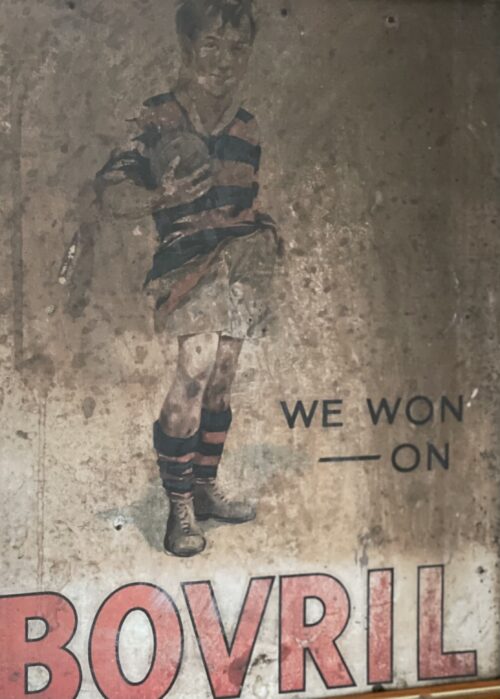
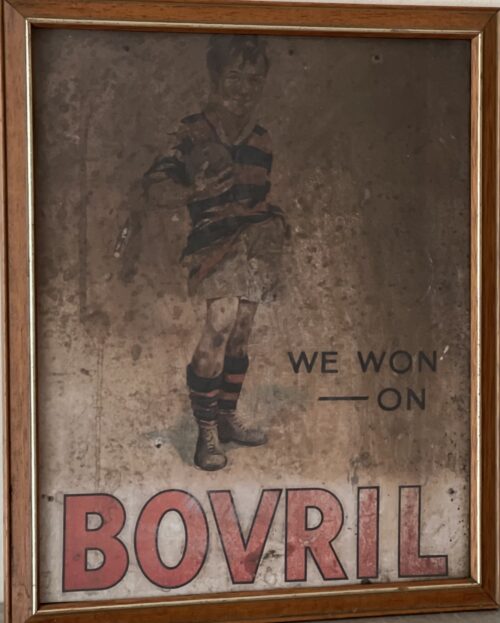 40cm x 34cm LimerickBovril is the trademarked name of a thick and salty meat extract paste similar to a yeast extract, developed in the 1870s by John Lawson Johnston. It is sold in a distinctive bulbous jar, and as cubes and granules. Bovril is owned and distributed by Unilever UK. Its appearance is similar to Marmite and Vegemite. Bovril can be made into a drink ("beef tea") by diluting with hot water or, less commonly, with milk.It can be used as a flavouring for soups, broth, stews or porridge, or as a spread, especially on toast in a similar fashion to Marmite and Vegemite. The first part of the product's name comes from Latin bovīnus, meaning "ox".Johnston took the -vril suffix from Edward Bulwer-Lytton's then-popular novel, The Coming Race (1870), the plot of which revolves around a superior race of people, the Vril-ya, who derive their powers from an electromagnetic substance named "Vril". Therefore, Bovril indicates great strength obtained from an ox.
40cm x 34cm LimerickBovril is the trademarked name of a thick and salty meat extract paste similar to a yeast extract, developed in the 1870s by John Lawson Johnston. It is sold in a distinctive bulbous jar, and as cubes and granules. Bovril is owned and distributed by Unilever UK. Its appearance is similar to Marmite and Vegemite. Bovril can be made into a drink ("beef tea") by diluting with hot water or, less commonly, with milk.It can be used as a flavouring for soups, broth, stews or porridge, or as a spread, especially on toast in a similar fashion to Marmite and Vegemite. The first part of the product's name comes from Latin bovīnus, meaning "ox".Johnston took the -vril suffix from Edward Bulwer-Lytton's then-popular novel, The Coming Race (1870), the plot of which revolves around a superior race of people, the Vril-ya, who derive their powers from an electromagnetic substance named "Vril". Therefore, Bovril indicates great strength obtained from an ox.History
 Poster for Bovril, about 1900; V&A Museum no. E.163-1973In 1870, in the Franco-Prussian War, Napoleon III ordered one million cans of beef to feed his troops. The task of providing this went to John Lawson Johnston, a Scotsman living in Canada. Large quantities of beef were available across the British Dominions and South America, but transport and storage were problematic. Therefore, Johnston created a product known as 'Johnston's Fluid Beef', later called Bovril, to meet Napoleon's needs.By 1888, over 3,000 UK public houses, grocers and dispensing chemists were selling Bovril. In 1889, Bovril Ltd was formed to develop Johnston's business further. During the 1900 Siege of Ladysmith in the Second Boer War, a Bovril-like paste was produced from horse meat within the garrison. Nicknamed Chevril (a portmanteau of Bovril and cheval, French for horse) it was produced by boiling down horse or mule meat to a jelly paste and serving it as a beef tea-like mixture. In addition, Bovril also produced concentrated, pemmican-like dried beef as part of the British Army emergency field ration during the war. The ration comes in the form of a pocket-sized tin can which contain the beef alongside a dried cocoa. The dried beef can be eaten alone, or mixed with water to create a beef tea. Bovril continued to function as a "war food" in World War I and was frequently mentioned in the 1930 account Not So Quiet: Stepdaughters of War by Helen Zenna Smith. It describes the drink being prepared for the casualties at Mons where "the orderlies were just beginning to make Bovril for the wounded, when the bearers and ambulance wagons were shelled as they were bringing the wounded into the hospital". Bovril beef tea was the only hot drink that Ernest Shackleton's team had when they were marooned on Elephant Island during the 1914-17 Endurance Expedition.[11] A thermos of beef tea was the favoured way to fend off the chill of winter season football matches for generations of British fans; Bovril dissolved in hot water is still sold in stadiums all over the United Kingdom. When John Lawson Johnston died, his son George Lawson Johnston inherited and took over the Bovril business. In 1929, George Lawson Johnston was made Baron Luke, of Pavenham, in the county of Bedford. Bovril's instant beef stock was launched in 1966 and its "King of Beef" range of instant flavours for stews, casseroles and gravy in 1971.In 1971, James Goldsmith's Cavenham Foods acquired the Bovril Company but then sold most of its dairies and South American operations to finance further take-overs. The brand is now owned by Unilever. Bovril holds the unusual distinction of having been advertised with a Pope. An advertising campaign of the early 20th century in Britain depicted Pope Leo XIII seated on his throne, bearing a mug of Bovril. The campaign slogan read: The Two Infallible Powers – The Pope & Bovril.
Poster for Bovril, about 1900; V&A Museum no. E.163-1973In 1870, in the Franco-Prussian War, Napoleon III ordered one million cans of beef to feed his troops. The task of providing this went to John Lawson Johnston, a Scotsman living in Canada. Large quantities of beef were available across the British Dominions and South America, but transport and storage were problematic. Therefore, Johnston created a product known as 'Johnston's Fluid Beef', later called Bovril, to meet Napoleon's needs.By 1888, over 3,000 UK public houses, grocers and dispensing chemists were selling Bovril. In 1889, Bovril Ltd was formed to develop Johnston's business further. During the 1900 Siege of Ladysmith in the Second Boer War, a Bovril-like paste was produced from horse meat within the garrison. Nicknamed Chevril (a portmanteau of Bovril and cheval, French for horse) it was produced by boiling down horse or mule meat to a jelly paste and serving it as a beef tea-like mixture. In addition, Bovril also produced concentrated, pemmican-like dried beef as part of the British Army emergency field ration during the war. The ration comes in the form of a pocket-sized tin can which contain the beef alongside a dried cocoa. The dried beef can be eaten alone, or mixed with water to create a beef tea. Bovril continued to function as a "war food" in World War I and was frequently mentioned in the 1930 account Not So Quiet: Stepdaughters of War by Helen Zenna Smith. It describes the drink being prepared for the casualties at Mons where "the orderlies were just beginning to make Bovril for the wounded, when the bearers and ambulance wagons were shelled as they were bringing the wounded into the hospital". Bovril beef tea was the only hot drink that Ernest Shackleton's team had when they were marooned on Elephant Island during the 1914-17 Endurance Expedition.[11] A thermos of beef tea was the favoured way to fend off the chill of winter season football matches for generations of British fans; Bovril dissolved in hot water is still sold in stadiums all over the United Kingdom. When John Lawson Johnston died, his son George Lawson Johnston inherited and took over the Bovril business. In 1929, George Lawson Johnston was made Baron Luke, of Pavenham, in the county of Bedford. Bovril's instant beef stock was launched in 1966 and its "King of Beef" range of instant flavours for stews, casseroles and gravy in 1971.In 1971, James Goldsmith's Cavenham Foods acquired the Bovril Company but then sold most of its dairies and South American operations to finance further take-overs. The brand is now owned by Unilever. Bovril holds the unusual distinction of having been advertised with a Pope. An advertising campaign of the early 20th century in Britain depicted Pope Leo XIII seated on his throne, bearing a mug of Bovril. The campaign slogan read: The Two Infallible Powers – The Pope & Bovril.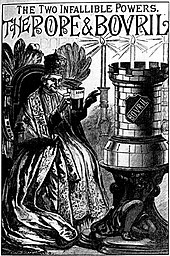 "The Two Infallible Powers: The Pope & Bovril"; poster for Bovril, c. 1900
"The Two Infallible Powers: The Pope & Bovril"; poster for Bovril, c. 1900 -
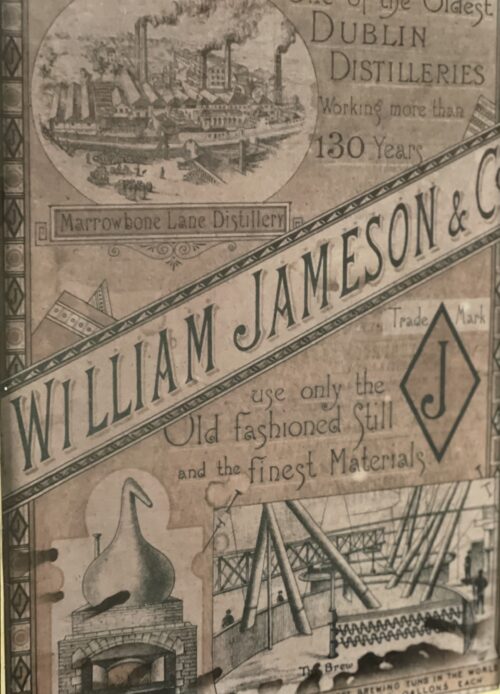
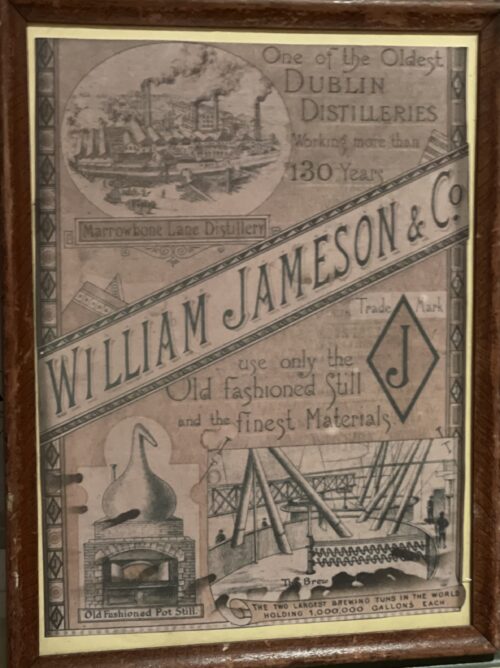 44cm x 34cm Dublin The Marrowbone Lane Distillery was an Irish whiskey distillery located on Marrowbone Lane, in Dublin, Ireland. One of the "big four" historical Dublin whiskey firms, it was run by William Jameson, a member of the Jameson whiskey dynasty. However, the whiskey now known as Jameson Irish Whiskey was not produced at this distillery, but at the separate enterprise run by John Jameson at the nearby Bow Street Distillery. The distillery closed in 1923 following financial difficulties.The precise origins of the distillery are uncertain, however, it was likely established in the 1750s (possibly 1752) and later acquired by the Stein family, relatives of the Jameson family circa 1780. An excise return in 1802 lists Stein and Jameson, however, by 1822 the company had become William Jameson & Co. Initially a small undertaking, with an output of just 30,000 gallons per annum, the distillery expanded over time, and by the time Alfred Barnard, a British historian visited the distillery in the 1880s, it had grown to cover some 14 acres. In his book, The Whisky Distilleries of the United Kingdom, Barnard described Marrowbone Lane as having some of the biggest distilling equipment in the world, including two mash tuns with capacities in excess of 100,000 gallons, which were the "said to be the largest in the United Kingdom". At its peak, the distillery was the second largest in Dublin (then one of the world's largest whiskey distilling centres), with an output of 900,000 gallons per annum, and a staff of 200, including 30 coopers. The whiskey produced at the distillery, known as "Dublin Whiskey" was chiefly exported to Australia, Canada, India and the United States. Later renamed the Dublin Distilling Company, the company entered financial difficulties in the late 1800s, and in 1891, merged with George Roe's Thomas Street Distillery and the Dublin Whiskey Distillery Company's Jones Road Distillery to form the Dublin Distilleries Company Ltd. Although, the amalgamated company had a potential production capacity of 3.5 million gallons per annum, it continued to endure severe financial difficulties, in particular, following the loss of both the American and British Commonwealth export markets during prohibition and the Anglo-Irish trade war in the 1920s. Both the Thomas Street and Marrowbone Lane distilleries closed in 1923, with the Jones Road Distillery following suit in 1926. Though distilling may have continued at Jones Road until 1946. During the 1916 Easter uprising, both the Marrowbone Lane distillery and Roe's distillery at Thomas Street were used as strongpoints by a force of more than a hundred rebels.
44cm x 34cm Dublin The Marrowbone Lane Distillery was an Irish whiskey distillery located on Marrowbone Lane, in Dublin, Ireland. One of the "big four" historical Dublin whiskey firms, it was run by William Jameson, a member of the Jameson whiskey dynasty. However, the whiskey now known as Jameson Irish Whiskey was not produced at this distillery, but at the separate enterprise run by John Jameson at the nearby Bow Street Distillery. The distillery closed in 1923 following financial difficulties.The precise origins of the distillery are uncertain, however, it was likely established in the 1750s (possibly 1752) and later acquired by the Stein family, relatives of the Jameson family circa 1780. An excise return in 1802 lists Stein and Jameson, however, by 1822 the company had become William Jameson & Co. Initially a small undertaking, with an output of just 30,000 gallons per annum, the distillery expanded over time, and by the time Alfred Barnard, a British historian visited the distillery in the 1880s, it had grown to cover some 14 acres. In his book, The Whisky Distilleries of the United Kingdom, Barnard described Marrowbone Lane as having some of the biggest distilling equipment in the world, including two mash tuns with capacities in excess of 100,000 gallons, which were the "said to be the largest in the United Kingdom". At its peak, the distillery was the second largest in Dublin (then one of the world's largest whiskey distilling centres), with an output of 900,000 gallons per annum, and a staff of 200, including 30 coopers. The whiskey produced at the distillery, known as "Dublin Whiskey" was chiefly exported to Australia, Canada, India and the United States. Later renamed the Dublin Distilling Company, the company entered financial difficulties in the late 1800s, and in 1891, merged with George Roe's Thomas Street Distillery and the Dublin Whiskey Distillery Company's Jones Road Distillery to form the Dublin Distilleries Company Ltd. Although, the amalgamated company had a potential production capacity of 3.5 million gallons per annum, it continued to endure severe financial difficulties, in particular, following the loss of both the American and British Commonwealth export markets during prohibition and the Anglo-Irish trade war in the 1920s. Both the Thomas Street and Marrowbone Lane distilleries closed in 1923, with the Jones Road Distillery following suit in 1926. Though distilling may have continued at Jones Road until 1946. During the 1916 Easter uprising, both the Marrowbone Lane distillery and Roe's distillery at Thomas Street were used as strongpoints by a force of more than a hundred rebels. -
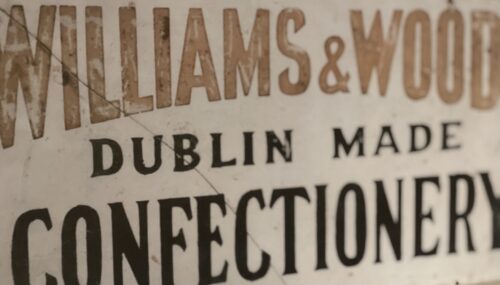
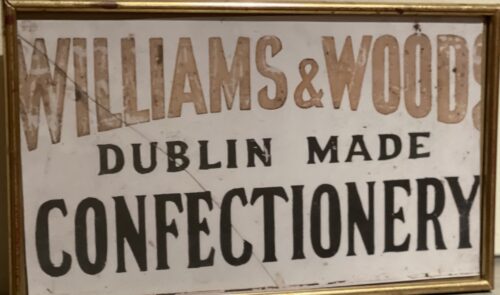 24cm x 40cm From the double-takes by people currently walking down King’s Inn Street at the doors to Williams and Woods , you might be forgiven for thinking the former confectionary factory is returning in some Willy Wonka spectacular. The building’s distinctive corner sign has snuck it into the city’s collective memory, making it deeply exciting to see boards coming away from the windows and the glazing being repaired. Williams and Woods moved to Great Britain Street (now Parnell Street) in 1875, operating as confectionary manufacturers and wholesalers. The company acquired adjacent sites, including land across Loftus Lane, and had a factory complex that produced sweets, preserves, canned goods and vinegar. (There’s a history of acquisitions – including being bought by Cross and Blackwell in 1928 – that’s a bit involved for our purposes, but it brings in many well-known names such as Chef, Toblerone, Keiller Little Chip, The National Canning Company of Ireland and Silvermints.) This particular part of the factory seems to have been built around 1900, completely destroyed by fire in 1908, and built again by 1910 (a jam factory designed by Donnelly & Moore), though it’s a little difficult to determine which part of the block is referred to in news reports.
24cm x 40cm From the double-takes by people currently walking down King’s Inn Street at the doors to Williams and Woods , you might be forgiven for thinking the former confectionary factory is returning in some Willy Wonka spectacular. The building’s distinctive corner sign has snuck it into the city’s collective memory, making it deeply exciting to see boards coming away from the windows and the glazing being repaired. Williams and Woods moved to Great Britain Street (now Parnell Street) in 1875, operating as confectionary manufacturers and wholesalers. The company acquired adjacent sites, including land across Loftus Lane, and had a factory complex that produced sweets, preserves, canned goods and vinegar. (There’s a history of acquisitions – including being bought by Cross and Blackwell in 1928 – that’s a bit involved for our purposes, but it brings in many well-known names such as Chef, Toblerone, Keiller Little Chip, The National Canning Company of Ireland and Silvermints.) This particular part of the factory seems to have been built around 1900, completely destroyed by fire in 1908, and built again by 1910 (a jam factory designed by Donnelly & Moore), though it’s a little difficult to determine which part of the block is referred to in news reports. -
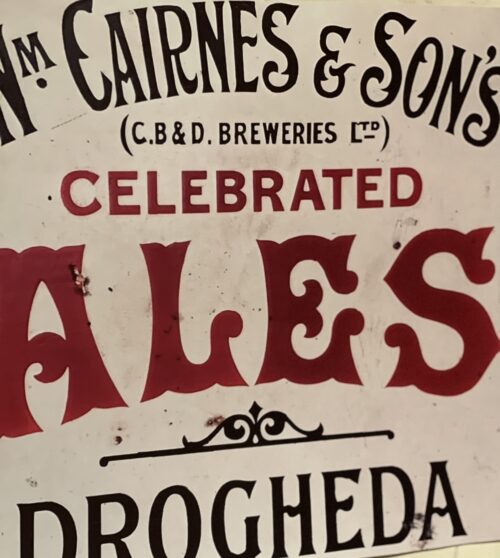
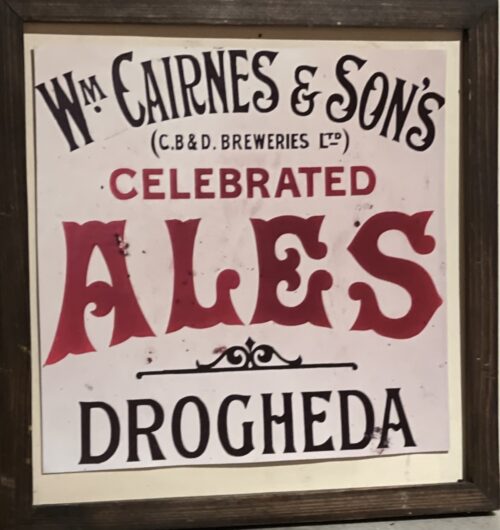 30cm x 30cm ANOTHER great industry on the Scotch Hall site was the brewing firm of Cairnes Ltd, one of the original firms of Irish brewers dating back to 1772 with the foundation of the Castlebellingham Brewery at the picturesque Co Louth village of that name.In 1825, William Cairnes, who was related by marriage to the owners of the ’Bellingham brewery, founded the brewery at Marsh Road, Drogheda, which, for over 150 years, gave employment to almost 200 workers and the firm was famous for its ales and stout. In 1889 the interests of the two breweries were pooled, a public company being formed under the title of the Castlebellingham and Drogheda Breweries Ltd. This title was changed for brevity in 1933 to Cairnes Ltd. For a good many years subsequent to the merger, the breweries were worked independently, each supplying its own customers throughout Ireland and abroad. However, in 1923, it was considered advisable to concentrate brewing in Drogheda, owing to the more advantageous position of the town, and the brewing plant and premises there, were more extensive. Actually the plant at Drogheda was one of the most up-to-date in Ireland and compared very favourably with that of breweries in England and Wales. The supply of brewing water was obtained from a 400ft deep artesian well on the company’s premises. (I wonder if it is still there) and this water was used with the choicest hops and malt made from the best Irish barley obtainable. The hops used came chiefly from Kent and when obtainable, a percentage came from the USA. The process through which the barley went from its arrival in the brewery until it emerged as ale or stout, was extremely interesting and quaint. The barley was first dried to a consistent level of moisture content and then stored for a few weeks before being steeped. It was then ‘floored’ on lots which the brewery had, as well as lofts in Dominic Street and Wellington Quay. These have, in recent years, been converted into shops and a high rise apartment block. Here on these lofts the growing process of the barley in the ground was artificially repeated, the growth however being terminated at the desired stage. The barley was then kilned and cured before being ground and mashed with hot water and the liquid was drawn off. It was then run to built-in coppers, where hops was added, then boiled, the wort, as it was called, being subsequently strained from the hops, cooled and fermented. The final stage was when the beer was casked (in wooden barrels) and matured.
30cm x 30cm ANOTHER great industry on the Scotch Hall site was the brewing firm of Cairnes Ltd, one of the original firms of Irish brewers dating back to 1772 with the foundation of the Castlebellingham Brewery at the picturesque Co Louth village of that name.In 1825, William Cairnes, who was related by marriage to the owners of the ’Bellingham brewery, founded the brewery at Marsh Road, Drogheda, which, for over 150 years, gave employment to almost 200 workers and the firm was famous for its ales and stout. In 1889 the interests of the two breweries were pooled, a public company being formed under the title of the Castlebellingham and Drogheda Breweries Ltd. This title was changed for brevity in 1933 to Cairnes Ltd. For a good many years subsequent to the merger, the breweries were worked independently, each supplying its own customers throughout Ireland and abroad. However, in 1923, it was considered advisable to concentrate brewing in Drogheda, owing to the more advantageous position of the town, and the brewing plant and premises there, were more extensive. Actually the plant at Drogheda was one of the most up-to-date in Ireland and compared very favourably with that of breweries in England and Wales. The supply of brewing water was obtained from a 400ft deep artesian well on the company’s premises. (I wonder if it is still there) and this water was used with the choicest hops and malt made from the best Irish barley obtainable. The hops used came chiefly from Kent and when obtainable, a percentage came from the USA. The process through which the barley went from its arrival in the brewery until it emerged as ale or stout, was extremely interesting and quaint. The barley was first dried to a consistent level of moisture content and then stored for a few weeks before being steeped. It was then ‘floored’ on lots which the brewery had, as well as lofts in Dominic Street and Wellington Quay. These have, in recent years, been converted into shops and a high rise apartment block. Here on these lofts the growing process of the barley in the ground was artificially repeated, the growth however being terminated at the desired stage. The barley was then kilned and cured before being ground and mashed with hot water and the liquid was drawn off. It was then run to built-in coppers, where hops was added, then boiled, the wort, as it was called, being subsequently strained from the hops, cooled and fermented. The final stage was when the beer was casked (in wooden barrels) and matured. -

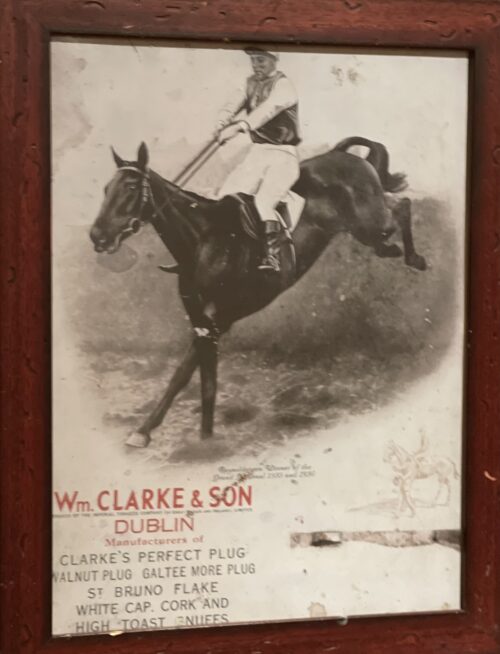 47cm x 35cm During its 180 year history, the Grand National has seen only five horses win consecutive runnings, with this year's victor Tiger Roll joining that exclusive list of dual winners. Until the legendary Red Rum, the last horse to win on his immediate return to Aintree was Reynoldstown, who won the 1935 Grand National in the hands of Mr Frank Furlong - a subaltern in the 9th Lancers - and again the following year ridden by Furlong's great friend and fellow Army officer Mr Fulke Walwyn, later to become a multi-time champion National Hunt trainer. Although two totally different kinds of horses, the long, lean, black Reynoldstown and the diminutive Tiger Roll share a parallel in that both had Flat-bred sires. Reynoldstown was by the good-class My Prince who won among other races the Union Jack Stakes at Aintree but went on to become more famous as an outstanding sire of National Hunt horses including Grand National winners Gregalach (1929) and Royal Mail (1937), while Tiger Roll's father Authorized won the 2007 Epsom Derby under Frankie Dettori. Reynoldstown's dam Fromage was the product of a modest mating to the nearest sire who was within walking distance.
47cm x 35cm During its 180 year history, the Grand National has seen only five horses win consecutive runnings, with this year's victor Tiger Roll joining that exclusive list of dual winners. Until the legendary Red Rum, the last horse to win on his immediate return to Aintree was Reynoldstown, who won the 1935 Grand National in the hands of Mr Frank Furlong - a subaltern in the 9th Lancers - and again the following year ridden by Furlong's great friend and fellow Army officer Mr Fulke Walwyn, later to become a multi-time champion National Hunt trainer. Although two totally different kinds of horses, the long, lean, black Reynoldstown and the diminutive Tiger Roll share a parallel in that both had Flat-bred sires. Reynoldstown was by the good-class My Prince who won among other races the Union Jack Stakes at Aintree but went on to become more famous as an outstanding sire of National Hunt horses including Grand National winners Gregalach (1929) and Royal Mail (1937), while Tiger Roll's father Authorized won the 2007 Epsom Derby under Frankie Dettori. Reynoldstown's dam Fromage was the product of a modest mating to the nearest sire who was within walking distance.Reynoldstown, named after the local townland of the small village of Naul near Dublin, was foaled there in 1927 by cattle farmer Dick Ball - who also bred the great Ballymoss. Dick's father had raised Fromage by hand himself after her mother died foaling. As a five-year-old, Reynoldstown was bought for £1,500 by Major Noel Furlong for his son Frank to ride in steeplechases. A leading Irish point-to-point rider himself, Major Furlong had had his interest in the Grand National sparked one year when, still in the Army, he'd travelled to Liverpool to watch the big race. In the train carriage, he overheard people talking about the chances of their horse winning and, when he saw this come to pass later that day, declared "That's it! I'm going to win the National myself." Major Furlong trained just two or three horses of his own in Skeffington, Leicestershire. Reynoldstown proved to be very hot and excitable throughout his career and was never ridden by anyone - at home or in races - apart from Major Furlong, Frank or Fulke. Reynoldstown won four hurdle races and eight 'chases before his first Grand National success in 1935, which saw him score by three lengths and break Golden Miller's record for the race - his time of 9 minutes 20.20 seconds standing until Red Rum beat it in 1973. The newspaper headlines ran: "Grand National won by two Furlongs!" Reynoldstown suffered leg problems afterwards which forced a long lay-off. Major Furlong followed the old adage "time, tar and tarmac", coating his legs with tar and giving him lots of roadwork to get him sound again. The horse duly came back to win the 1936 Grand National by twelve lengths, this time in the hands of Walwyn, since Frank Furlong was unable to make the weight. There was drama at the final fence after the reins broke on challenger Davy Jones, leaving rider Anthony Mildmay (after whom the Mildmay Course at Aintree is named) powerless to prevent the horse running out into the crowds. Reynoldstown did not attempt the hat trick. He was retired immediately after his Grand National success, the Furlongs considering - not unlike the connections of Tiger Roll - that he had done enough to prove himself and owing them nothing. He spent his retirement with Major Furlong at Marston St Lawrence near Banbury, where he was put down at the age of 24 after contracting tetanus. He is buried there, alongside the 1972 Grand National winner Well To Do. Curiously, he was never turned out in the field but was exercised instead on a lungeing rein by his devoted lifelong groom McCarthy, who brushed him and took him for a pick of grass and a welcome roll every day. Sadly, for Major Furlong, the aftermath was not so happy. His son Frank, who had left the Army and set up training himself near Lambourn, enlisted in the Fleet Air Arm at the outbreak of World War II and, though flying successfully on many combat missions, was killed when the Spitfire prototype Spiteful he was testing developed a fault and crashed on Salisbury Plain in 1944. He left a widow and a baby daughter, Grizelda, who today, as an octogenarian, recalls with affection being brought up by her grandparents and sitting on Reynoldstown's back as a pony-mad youngster. She clearly remembers stories Major Furlong would tell, including that of the 1934 Grand National in which both Frank and Fulke rode. Both their horses came down at the 26th fence when going well and the two riders were left thumping the turf in frustration. Major Furlong confronted the disgruntled friends in the Weighing Room afterwards with the prophetic words: "Don't worry, I shall have a Grand National winner for both of you." Another tale he told her concerned Frank and Fulke, in a hurry to reach the traditional party at the Adelphi Hotel, joyfully overtaking the traffic jams outside Aintree after one of their National wins. A policeman pulled the singing and shouting pair over with the words "What do you think you're doing? Anyone would think you'd just won the Grand National!" Grizelda smiles when she recounts her grandfather telling her how Reynoldstown's horsebox was held up by a funeral on the way to the 1935 Grand National. Major Furlong considered it lucky to see a funeral so the following year waited around in the hope of another before they reached the course. None appeared - but they did manage to spot a black cat - which obviously had the same desired effect. Quote: Attempting to compare Reynoldstown and Tiger Roll, Grizelda says: "The Grand National today is a totally different race and the fences are so much smaller. You cannot compare the two, but Tiger Roll is obviously a wonderful horse and thoroughly deserved both his wins and the adulation he received. We always gathered round as a family to watch the National on TV and this year was no exception. I really did think Tiger Roll would win." William Clarke & Son was a tobacco company that was founded in 1830 at South Main Street, Cork, Ireland. In January 1924, following the formation of the Irish Free State, the United Kingdom trade of William Clarke & Son was transferred to Dublin and taken over by Ogden's.
William Clarke & Son, Dublin
William Clarke was founded in 1830 at South Main Street in Cork, however by 1870 the manufacturing side of the business had all been transferred to Hare Place, Scotland Road, Liverpool, with only depots remaining in Ireland. Following the formation of the Irish Free State in 1926, the Liverpool based operation was taken over by Ogden’s, while a new factory was set up at South Circular Road in Dublin to produce tobacco and snuff under the William Clarke & Son brand. In 1929 William Clarke was amalgamated with Wills’s Irish branch, which resulted in Wills’s Irish production being integrated into the new South Circular Road factory in Dublin, though senior management were based in Wills’s Bristol operations and the Irish entity ultimately reported back into Bristol.





